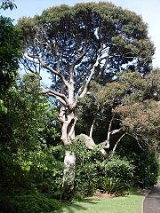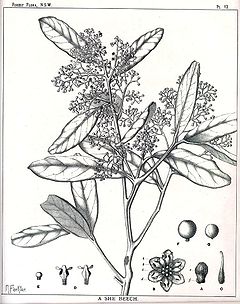
Cryptocarya obovata
Encyclopedia
Cryptocarya obovata is a large laurel
growing on basaltic and fertile alluvial soils in eastern Australian rainforests. It is found from Wyong (33° S) in New South Wales
to Gympie
(27° S) in the state of Queensland
. Extinct in the Illawarra
region (34° S), seen in the Illawarra in 1818 by Allan Cunningham
. Published in Prodromus Florae Novae Hollandiae et Insulae Van Diemen
, 402 (1810)
Leaves are alternate, obovate or oblong, 6 to 12 cm long, with a round tip. Upper surface smooth and glossy, underside usually greyish and finely hairy. Brown leaf stalks 3 to 8 mm long.
Leaf venation is prominent, the raised midrib, lateral and net veins are covered with brown hairs, standing out conspicuously. Veins brownish/orange or yellow in colour.

The fruit is a black globular drupe
, usually ribbed. 12 mm in diameter. The seed is around 8 mm in diameter. Fruit ripe from March to May. Eaten by Australasian Figbird
, Rose-crowned Fruit-dove
, Topknot Pigeon
and Wompoo Fruit Dove.
Like most Australian Cryptocarya
fruit, removal of the fleshy aril
is advised to assist seed germination, which is slow with Cryptocarya obovata After 205 days, a 50% germination success may be expected.
Lauraceae
The Lauraceae or Laurel family comprises a group of flowering plants included in the order Laurales. The family contains about 55 genera and over 3500, perhaps as many as 4000, species world-wide, mostly from warm or tropical regions, especially Southeast Asia and South America...
growing on basaltic and fertile alluvial soils in eastern Australian rainforests. It is found from Wyong (33° S) in New South Wales
New South Wales
New South Wales is a state of :Australia, located in the east of the country. It is bordered by Queensland, Victoria and South Australia to the north, south and west respectively. To the east, the state is bordered by the Tasman Sea, which forms part of the Pacific Ocean. New South Wales...
to Gympie
Gympie
Gympie may refer to:* Gympie, a city in Queensland, Australia** Gympie Airport** Electoral district of Gympie** Gympie Region, its local government authority* Gympie Gympie , a stinging plant...
(27° S) in the state of Queensland
Queensland
Queensland is a state of Australia, occupying the north-eastern section of the mainland continent. It is bordered by the Northern Territory, South Australia and New South Wales to the west, south-west and south respectively. To the east, Queensland is bordered by the Coral Sea and Pacific Ocean...
. Extinct in the Illawarra
Illawarra
Illawarra is a region in the Australian state of New South Wales. It is a coastal region situated immediately south of Sydney and north of the Shoalhaven or South Coast region. It encompasses the cities of Wollongong, Shellharbour, Shoalhaven and the town of Kiama. The central region contains Lake...
region (34° S), seen in the Illawarra in 1818 by Allan Cunningham
Allan Cunningham (botanist)
Allan Cunningham was an English botanist and explorer, primarily known for his travels in New South Wales to collect plants.- Early life :...
. Published in Prodromus Florae Novae Hollandiae et Insulae Van Diemen
Prodromus Florae Novae Hollandiae et Insulae Van Diemen
Prodromus Florae Novae Hollandiae et Insulae Van Diemen is an 1810 flora of Australia by botanist Robert Brown. Often referred to as Prodromus Flora Novae Hollandiae, or by its standard botanical abbreviation Prodr. Fl. Nov. Holland., it was the first attempt at a survey of the Australian flora...
, 402 (1810)
Description
Cryptocarya obovata, known as the Pepperberry or White Walnut reaches a height of 40 metres and a trunk diameter of 90 cm. The hairy underside of the leaves gives a rusty appearance of the tree, when viewed from below.Trunk, bark & leaves
The trunk is straight and round in cross section, usually buttressed. The bark is grey or brown and usually fairly smooth. Vertical lines of pustules are often seen.Leaves are alternate, obovate or oblong, 6 to 12 cm long, with a round tip. Upper surface smooth and glossy, underside usually greyish and finely hairy. Brown leaf stalks 3 to 8 mm long.
Leaf venation is prominent, the raised midrib, lateral and net veins are covered with brown hairs, standing out conspicuously. Veins brownish/orange or yellow in colour.

Flowers, fruit & germination
Cream flowers in panicles. Individual flowers about 3 mm long, almost without stalks. Flowering occurs between February to May.The fruit is a black globular drupe
Drupe
In botany, a drupe is a fruit in which an outer fleshy part surrounds a shell of hardened endocarp with a seed inside. These fruits develop from a single carpel, and mostly from flowers with superior ovaries...
, usually ribbed. 12 mm in diameter. The seed is around 8 mm in diameter. Fruit ripe from March to May. Eaten by Australasian Figbird
Australasian Figbird
The Australasian Figbird is a conspicuous medium-sized passerine bird native to a wide range of wooded habitats in northern and eastern Australia, southern Papua New Guinea, and the Kai Islands in Indonesia. It was formerly considered a subspecies of S...
, Rose-crowned Fruit-dove
Rose-crowned Fruit-dove
The Rose-crowned Fruit Dove, Ptilinopus regina, also known as Pink-capped Fruit Dove or Swainson's Fruit Dove, is a medium-sized, up to 22 cm long, green fruit dove with a grey head and breast, an orange belly, whitish throat, yellow-orange iris, and greyish green bill and feet. It has a...
, Topknot Pigeon
Topknot Pigeon
The Topknot Pigeon is a pigeon native to Australia. It is also known by the name of "Flock Pigeon".-Description:...
and Wompoo Fruit Dove.
Like most Australian Cryptocarya
Cryptocarya
Cryptocarya is a genus of evergreen trees belonging to the Laurel family, Lauraceae. The genus includes more than 350 species, distributed through the Neotropic, Afrotropic, Indomalaya, and Australasia ecozones.-Overview:...
fruit, removal of the fleshy aril
Aril
An aril is any specialized outgrowth from the funiculus that covers or is attached to the seed. It is sometimes applied to any appendage or thickening of the seed coat in flowering plants, such as the edible parts of the mangosteen and pomegranate fruit, the mace of the nutmeg seed, or the...
is advised to assist seed germination, which is slow with Cryptocarya obovata After 205 days, a 50% germination success may be expected.

